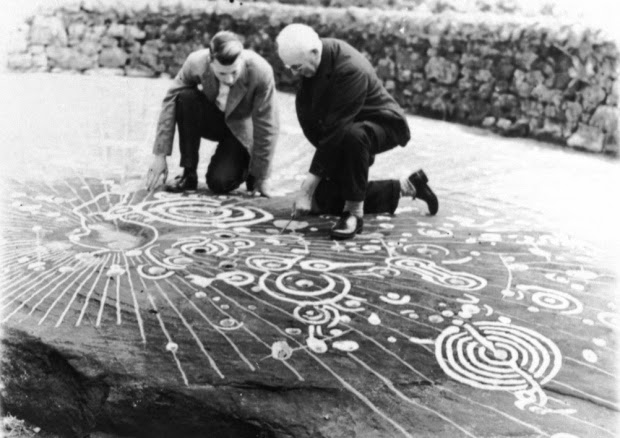Cochno Stones: Archaeology and Bouldering
High above the residential northern shores of the Clyde is a strip of sandstone geology outcropping all the way to Craigmaddie Muir in the east. It lies hidden under a mossy understorey mostly, and varies in consistency and quality, but was once the attention of neolithic archaeologists, until they had to bury what is one of Scotland's greatest rock-art sites.The 'Cochno Stone' was uncovered by the Rev James Harvey in 1887 on open land near what is now the Faifley housing estate. It is covered with dozens of cup and ring marks, grooved spirals, along with a ringed cross and a pair of four-toed feet. It was briefly a chalked-in tourist attraction until it was buried to prevent vandalism in 1964.
Rock-art these days is a kinaesthetic thing, recorded as bouldering on photo-video networks, rather than pecked out on rock plinths. I've always like the connection between the vibrant, fluid circles and lines inscribed on the rock and the modern tracery of bouldering; there is a long connection of being in the same place, despite the different physicalities, changed rituals and contexts. Bouldering is a ritual of uncovering climbing movement, moving on in stations to the next problem, a kind of sporting religion. Every climber knows the call, the Sunday bells of unclimbed rocks...
The Cochno Stones, as I call them, are nearby crags and blocs at Auchnacraig car-park which have seen the light after a rhododendron cull. Under their mossy garb are various gritstone-like problems complete with embedded river pebbles from an ancient flood. Drying out nicely and desperate for traffic, they sit at the entrance to Auchnacraig House by the car-park for the Faifley walks. Take a brush and go make some modern rock-art!
Rock-art these days is a kinaesthetic thing, recorded as bouldering on photo-video networks, rather than pecked out on rock plinths. I've always like the connection between the vibrant, fluid circles and lines inscribed on the rock and the modern tracery of bouldering; there is a long connection of being in the same place, despite the different physicalities, changed rituals and contexts. Bouldering is a ritual of uncovering climbing movement, moving on in stations to the next problem, a kind of sporting religion. Every climber knows the call, the Sunday bells of unclimbed rocks...
The Cochno Stones, as I call them, are nearby crags and blocs at Auchnacraig car-park which have seen the light after a rhododendron cull. Under their mossy garb are various gritstone-like problems complete with embedded river pebbles from an ancient flood. Drying out nicely and desperate for traffic, they sit at the entrance to Auchnacraig House by the car-park for the Faifley walks. Take a brush and go make some modern rock-art!
Smithless Wall 6a
Cochno Prow 6b
Punjab Buffet 7a+






